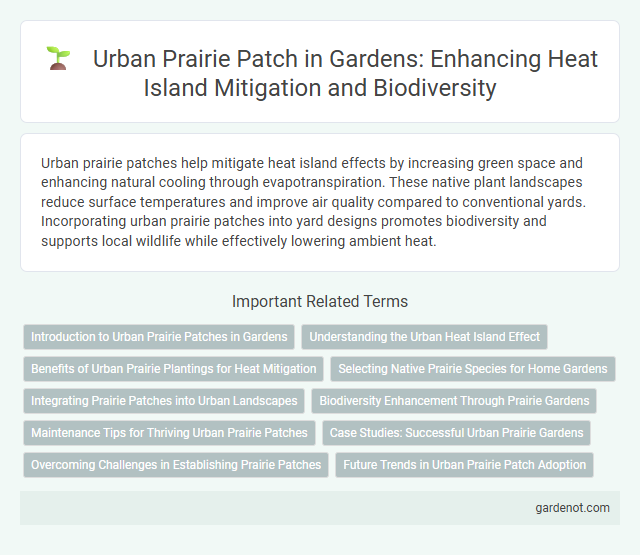Urban prairie patches help mitigate heat island effects by increasing green space and enhancing natural cooling through evapotranspiration. These native plant landscapes reduce surface temperatures and improve air quality compared to conventional yards. Incorporating urban prairie patches into yard designs promotes biodiversity and supports local wildlife while effectively lowering ambient heat.
Introduction to Urban Prairie Patches in Gardens
Urban prairie patches in gardens serve as effective heat island mitigation strategies by incorporating native grasses and wildflowers that enhance evapotranspiration and provide shade. These patches increase biodiversity and improve soil health, contributing to cooler microclimates in urban settings. Integrating urban prairie patches reduces surface temperatures and supports sustainable landscaping practices that combat urban heat effects.
Understanding the Urban Heat Island Effect
Urban prairie patches help mitigate the urban heat island effect by increasing vegetation cover, which enhances evapotranspiration and provides shade. These green spaces lower surface temperatures and reduce heat absorption in densely built environments. Studies show that integrating prairie plants in urban landscapes can decrease local temperatures by up to 5degC during peak heat periods.
Benefits of Urban Prairie Plantings for Heat Mitigation
Urban prairie plantings significantly reduce surface temperatures through increased evapotranspiration and shading, helping to mitigate urban heat island effects. Native grasses and wildflowers enhance soil moisture retention and promote biodiversity, creating a cooler microclimate in densely built environments. These prairie patches also improve air quality by filtering pollutants and sequestering carbon, contributing to overall urban heat island reduction.
Selecting Native Prairie Species for Home Gardens
Selecting native prairie species for home gardens in urban prairie patches enhances heat island mitigation by promoting natural cooling through increased evapotranspiration and shading. Species like little bluestem (Schizachyrium scoparium), purple coneflower (Echinacea purpurea), and prairie dropseed (Sporobolus heterolepis) are well-adapted to local climates, requiring minimal irrigation and supporting native pollinators. Incorporating these resilient plants into urban landscapes reduces surface temperatures and improves biodiversity, contributing to sustainable heat island reduction strategies.
Integrating Prairie Patches into Urban Landscapes
Integrating urban prairie patches into cityscapes significantly reduces heat island effects by enhancing natural cooling through plant transpiration and shading. Native prairie vegetation supports biodiversity and improves stormwater management by increasing soil permeability. Strategic placement of these prairie patches in urban heat hotspots maximizes temperature regulation and promotes resilient urban ecosystems.
Biodiversity Enhancement Through Prairie Gardens
Urban prairie patches significantly boost biodiversity by providing native grasses and wildflowers that support pollinators such as bees and butterflies. These prairie gardens create habitats for birds and beneficial insects, fostering ecological balance within heat island mitigation yards. Incorporating diverse prairie species enhances soil health and water retention, contributing to sustainable urban ecosystems.
Maintenance Tips for Thriving Urban Prairie Patches
Regularly removing invasive species ensures native plants in urban prairie patches thrive, promoting biodiversity and effective heat island mitigation. Seasonal mowing helps maintain plant health and supports habitat diversity by encouraging native wildflowers and grasses to flourish. Consistent watering during dry spells boosts plant resilience, improving the prairie patch's ability to cool urban environments and reduce surface temperatures.
Case Studies: Successful Urban Prairie Gardens
Urban prairie patches effectively reduce heat island effects by increasing green space and promoting native vegetation that supports local biodiversity. Case studies in cities like Chicago and Minneapolis demonstrate significant temperature reductions and improved air quality through the establishment of diverse prairie gardens. These projects highlight the importance of native grasses and wildflowers in creating sustainable, low-maintenance urban habitats that enhance microclimate regulation.
Overcoming Challenges in Establishing Prairie Patches
Establishing urban prairie patches as a heat island mitigation strategy involves overcoming challenges such as soil compaction, limited native seed availability, and invasive species management. Selecting drought-tolerant native grasses like little bluestem (Schizachyrium scoparium) and switchgrass (Panicum virgatum) enhances resilience in urban environments with variable soil quality. Effective community engagement and maintenance plans contribute to the long-term success and ecological benefits of prairie patches in reducing urban heat.
Future Trends in Urban Prairie Patch Adoption
Urban prairie patches are increasingly integrated into heat island mitigation strategies due to their ability to reduce surface temperatures and enhance urban biodiversity. Emerging trends show a rise in the use of native grasses and wildflowers to create resilient, low-maintenance green spaces that improve air quality and manage stormwater runoff. Advances in remote sensing and climate modeling are driving design optimization and targeted placement of urban prairie patches for maximum cooling effects.
Urban prairie patch Infographic

 gardenot.com
gardenot.com